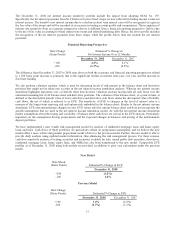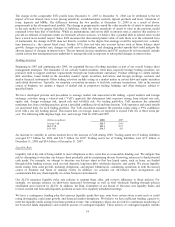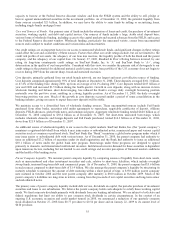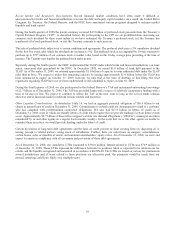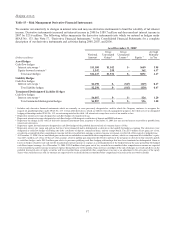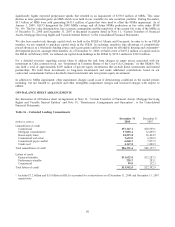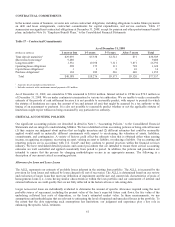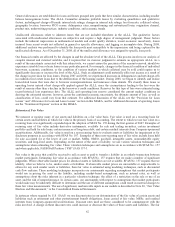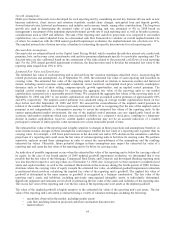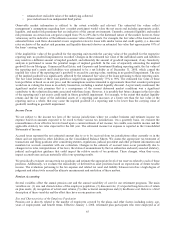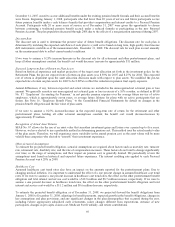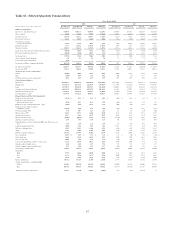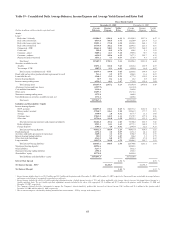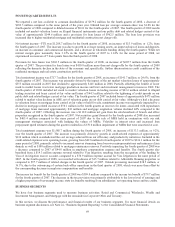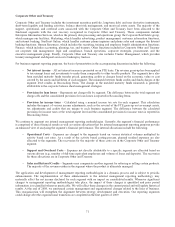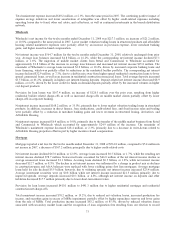SunTrust 2008 Annual Report Download - page 75
Download and view the complete annual report
Please find page 75 of the 2008 SunTrust annual report below. You can navigate through the pages in the report by either clicking on the pages listed below, or by using the keyword search tool below to find specific information within the annual report.value of MSRs is based on discounted cash flow analyses. We provide disclosure of the key economic assumptions used to
measure MSRs and residual interests and a sensitivity analysis to adverse changes to these assumptions in Note 11, “Certain
Transfers of Financial Assets, Mortgage Servicing Rights and Variable Interest Entities,” to the Consolidated Financial
Statements. A detailed discussion of key variables, including the discount rate, used in the determination of retirement and
other postretirement obligations is contained in the “Pension Accounting” section below.
In estimating the fair values for investment securities and most derivative financial instruments, we believe that independent,
third-party market prices are the best evidence of exit price. If such third-party market prices are not available on the exact
securities that we own, fair values are based on the market prices of similar instruments, third-party broker quotes or are
estimated using industry-standard or proprietary models whose inputs may be unobservable. When market observable data is
not available, the valuation of financial instruments becomes more subjective and involves substantial judgment. The need to
use unobservable inputs generally results from the lack of market liquidity for certain types of loans and securities, which
results in diminished observability of both actual trades and assumptions that would otherwise be available to value these
instruments. The distressed market conditions, that began in the third quarter of 2007 and continued through 2008, have
impacted our ability to obtain third-party pricing data for certain of our investments. Even when third-party pricing has been
available, the reduced trading activity resulting from current market conditions has challenged the observability of these
quotations. When fair values are estimated based on internal models, we will consider relevant market indices that correlate
to the underlying collateral, along with assumptions such as liquidity discounts, interest rates, prepayment speeds, default
rates, loss severity rates, and discount rates.
The fair values of loans held for investment recorded at fair value and loans held for sale are based on observable current
market prices in the secondary loan market in which loans trade, as either whole loans or as ABS. When securities prices are
obtained in the secondary loan market, we will translate these prices into whole loan prices by incorporating adjustments for
estimated credit enhancement costs, loan servicing fees, and various other transformation costs, when material. The fair value
of a loan is impacted by the nature of the asset and the market liquidity. When observable market prices are not available, for
example as a result of the current illiquidity in the market for certain loan products, we will use judgment and estimate fair
value using internal models. When estimating fair value, we will make assumptions about prepayment speeds, default rates,
loss severity rates, and liquidity discounts. Absent comparable current market data, we believe that the fair value derived
from these various approaches is a reasonable approximation of the prices that we would receive upon sale of the loans.
The fair values of OREO and other repossessed assets are typically determined based on recent appraisals by third parties,
less estimated selling costs. Estimates of fair value are also required when performing an impairment analysis of goodwill,
intangible assets and long-lived assets. For long-lived assets, including intangible assets subject to amortization, an
impairment loss is recognized if the carrying amount of the asset is not recoverable and exceeds its fair value. In determining
the fair value, management uses models which require assumptions about growth rates, the life of the asset, and/or the market
value of the assets. We test long-lived assets for impairment whenever events or changes in circumstances indicate that our
carrying amount may not be recoverable.
Goodwill
We review the goodwill of each reporting unit for impairment on an annual basis, or more often, if events or circumstances
indicate that it is more likely than not that the fair value of the reporting unit is below the carrying value of its equity. In
2008, our reporting units were comprised of Retail, Commercial, Commercial Real Estate, Mortgage, Corporate and
Investment Banking, Wealth and Investment Management, and Affordable Housing.
Valuation Techniques
In determining the fair value of our reporting units, we primarily use discounted cash flow analyses, which require
assumptions about short and long-term net cash flow growth rates for each reporting unit, as well as discount rates. In
addition, in 2008, we also applied guideline company and guideline transaction information, where available, to aid in the
valuation of certain reporting units. The guideline information was based on publicly available information. A valuation
multiple was selected based on a financial benchmarking analysis that compared the reporting unit’s benchmark result with
the guideline information. In addition to these financial considerations, qualitative factors such as asset quality, growth
opportunities, and overall risk were considered in the ultimate selection of the multiple used to estimate a value on a minority
basis. A control premium of 30% was applied to the minority basis value to arrive at the reporting unit’s estimated fair value
on a controlling basis. The values separately derived from each valuation technique (i.e., discounted cash flow, guideline
company, and guideline transaction) were used to develop an overall estimate of a reporting unit’s fair value. Generally, the
discounted cash flow analysis was weighted 60% and the market based approaches were weighted 40% in the final estimated
value. The selection and weighting of the various fair value techniques may result in a higher or lower fair value. Judgment is
applied in determining the weightings that are most representative of fair value.
63


